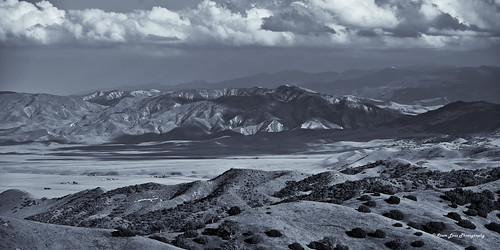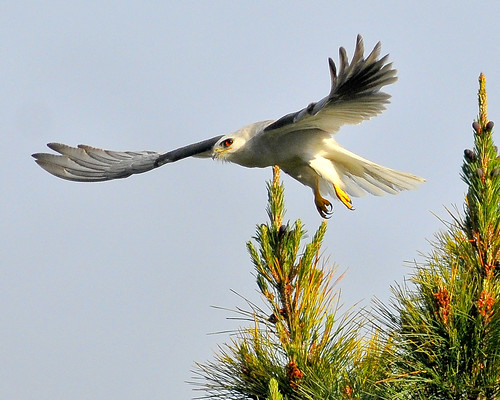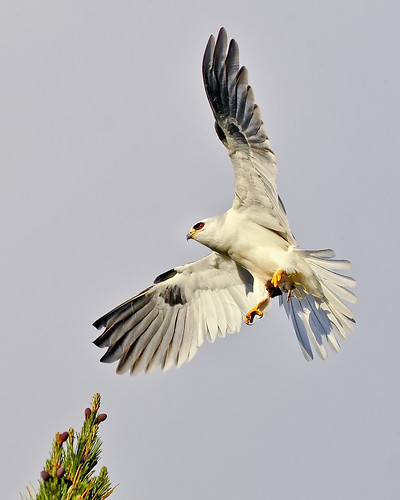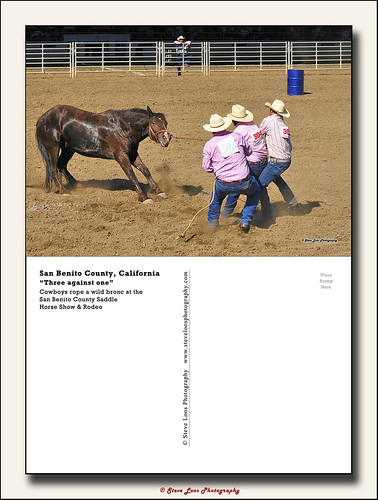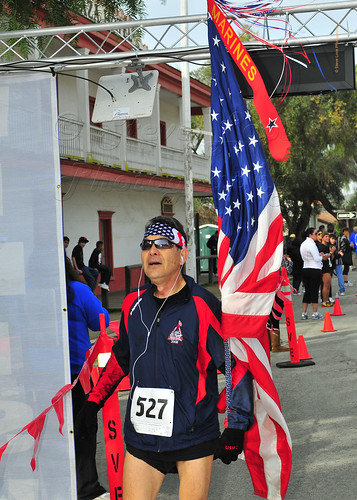Another shot of my family of White Tail Kites living in my backyard in Hollister California (see previous post for another shot.) These birds setup their nets way at the top of an old pine in my backyard, and the nest is invisible from the ground. I can tell when Mom is in the nest as I hear her screeching and chirping at any bird that gets to close! This is a shot of the Male; he seems to be a happy fellow and loves to harass he crows that also hang out in the in the pines.
Michael Garvin made a great comment on the previous photo, that the tree branches in the frame give the photo depth of field. This is a great point. My favorite flying bird images have a tree or soft background somewhere in the frame. This gives the image some depth and scale; my eye gets lost looking at an image of a bird flying against a featureless sky. Also the best time for me to photograph birds is at first light in the morning or at sunset; this puts the suns angle very low so the undersides of the wing and body have beautiful soft light.
How did I take this photo?
A few folks asked about the equipment and settings I use to take bird photos. I started out to write a short simple answer. Instead I wrote a long answer with simple advice; I hope it is useful.
My best advice
Know your equipment! Spend time reading the user manual and visiting blogs that discuss your camera. DPreview.com and kenrockwell.com are two popular sites. I have missed out on great shots because I forgot how to quickly setup or change a setting on my camera.
Go to bird and wildlife photographers websites and blogs. Pay attention to the camera settings and time of day, and read about how they took the image; this is far more important that the equipment! Quit a fiew "consumer level DSLR cameras" (i.e. cameras that cost less than your first car) are capable of great wildlife photos. If you read enough you will see that many great images are taken with non-professional equipment by photographers who have mastered the equipment they use.
Many photographers spend thousands of dollars on the newest and greatest gear, or the "professional" grade equipment and still get poor results. Do not use dollars to chase image quality!
When shooting birds or other wildlife do not rely on any auto setting in your camera. Do not use the "P" program mode, or any of the presets including "wildlife" or "pets." These settings can be great in many situations, but when shooting wildlife the chances at a good image come and go so quickly you don't want to leave that chance up to the camera. The auto settings are asking the camera to make all the decisions about lighting, exposure, focus, shutter speed, aperture and ISO. When the "auto" photos are not coming out as expected it is often difficult to decide what settings to change as you don't always know what the camera is doing!
Go outside and practice on leafs, pine cones, chimneys, fence posts, squirrels, bugs, kids (go shoot kids at a soccer game ~ you will learn a lot of good stuff!) Practice on all the common birds and wildlife in your yard, even your dog and cat; I have captured some great bird images while practicing.
I can't stress this enough. Most chances to capture good wildlife images come in 15 second blocks of time out of hours of waiting. You will ruin your enjoyment if you miss these shots due to not knowing your equipment and techniques. Being able to adjust your camera quickly to match a certain situation is a must have skill!
Equipment
I prefer small sensor cameras as these provide higher effective focal length while maintaining resolution; this was taken with a D300 which has a 1.5x crop sensor that makes a 300mm lens will be similar to a 450mm lens on a full frame camera.
This helps a lot on bird images but you still have to be close; I was less than 150’ from the bird at most times and still had to crop 25% to 50%.
I used a 300mm f2.8 lens. This lens is “fast” in that it lets in a lot of light allowing for faster shutter speeds; fast shutter speeds are a must with birds and sports. An f2.8 lens is twice as "fast" as a f4 lens in that the f2.8 lens can let in twice as much light as an f4 lens. Does this matter if both lens are shot at f5.6? Maybe; many lenses have a sweet spot one or two f stops higher than the widest aperture; the f2.8 may be a lot sharper at f5.6 than the f4. Also I can keep shooting in low morning and evening light, my favorite times to shoot wildlife. Another popular lens is the 400mm f4; slower so must be used in good light for fast shutter speeds but I have seen many beautiful wildlife and landscape images taken with this lens.
The 300 f2.8 is a "prime" lens as a opposed to a "zoom" lens. A 70-200mm f2.8 is a "zoom" lens as opposed to a "prime" lens. I find the images that come from prime lens sharper with better detail and color; this is due to lens design. A zoom lens has more moving parts and more glass in order to make the lens zoom and this can compromise image quality. There are some great zoom lens in the market and these can be a better value for many people as they are far more versatile than prime lens; if you have a 300mm lens on your camera and you want to shoot a wide landscape, you'll need another lense.
Keep in mind the longer the lens (a 400mm lens is "longer" than a 200mm lens and has more magnification) the higher the shutter speed required for a sharp image, especially handheld. Also, the new vibration reduction ("VR") lenses will not help shooting fast moving objects. The VR is useful for low light hand held photography of slow moving or stationary objects. When chasing fast moving objects sometimes the VR must be turned off; "VR" is not a useful feature for sports or bird photography.



